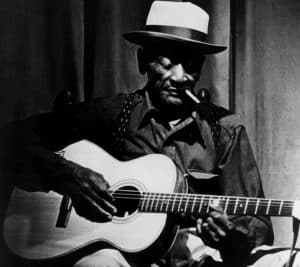 Blues is one of the most satisfying genres of music to play on guitar. It’s also the music every genre of rock and more aggressive directions evolved from. It’s the base code of modern metal.
Blues is one of the most satisfying genres of music to play on guitar. It’s also the music every genre of rock and more aggressive directions evolved from. It’s the base code of modern metal.
One of the most beautiful things about blues is how expressive it is. The amount of emotion you can pack into a blues song is immense.
This is why it is loved by everyone, regardless of their taste in music. Learning how to play blues is neither easy nor hard.
The thing about this type of music is that you can achieve the same result with riffs packed with jaw dropping licks, and several simple chords on an acoustic guitar.
There are just so many ways you can play blues in general. Today we are going to give you a couple of blues riffs tabs that are easy and satisfying to play. We will start from the easy ones and go to more complex riffs.
Hopefully, by the end of this article you will be able to play blues with a decent amount of understanding regarding what goes into blues, and what makes it so special.
Get in to Blues
The easiest type of blues you can play is the 12 bar blues. This is a name given to a very simple chord progression that has been played for almost a century now.
You can play 12 bar blues on acoustic as well as electric guitar.
Speaking of which, it definitely sounds impressive when you add just a pinch of overdrive to your signal. Let’s see how to play 12 bar blues.
As its name indicates, this type of blues consists from twelve bars, or measures. We are going to divide these into three groups or statements. Now, the there are typically three chords being played in 12 bar blues.
Usually they are the chords derived from the 1st, 4th and 5th note of an eight note scale. This might sound confusing in the beginning, but it’s important to remember this because this will allow you to derive the 12 bar blues progression from just about any key. We are going to give you an example of 12 bar blues played in the key of E. It goes something like this.
E7-A7-E7-E7
A7-A7-E7-E7
B7-A7-E7-B7
You can switch the root chord for any one you like, and use the 1-IV-V rule to derive the chords you’re going to insert into this matrix. The beauty of 12 bar blues is its simplicity. However, you definitely go ahead and spice things up. How to do that is what we are about to discuss in the next paragraph.
What you see on the picture above is the E Major pentatonic scale. If this looks overwhelming, don’t worry. We are going to make it real simple. So you have probably noticed how many blues guitar players like to insert small licks into their songs.
These licks are derived from a much more complex scale. One of the easiest scales that are used in blues is Major and Minor pentatonic scales. We are going to stick to the Major pentatonic scale for the purpose of this article.
 The way you can incorporate this scale into any type of blues, including the 12 bar blues we talked about earlier, is to take snippets from the scale and play them at specific times throughout the song. So, for example you are reaching the end of the first statement in our 12 bar blues progression.
The way you can incorporate this scale into any type of blues, including the 12 bar blues we talked about earlier, is to take snippets from the scale and play them at specific times throughout the song. So, for example you are reaching the end of the first statement in our 12 bar blues progression.
We are in the key of E so this scale above applies. Instead of playing the last measure in the first statement, which would be the E7 chord, you can play a lick derived from this scale instead.
You don’t have to start shredding the notes. All you need to do is play a triplet, or a set of four notes from the scale. Add bends and you already have a pretty decent sounding blues right there.
Conclusion
Hopefully this article has helped you understand the basics of blues, and how you can play it right away.
There’s a lot of blues riffs tabs on the web which you can use to practice your skills. However, you will notice that a great deal of them follow these simple rules as well.
